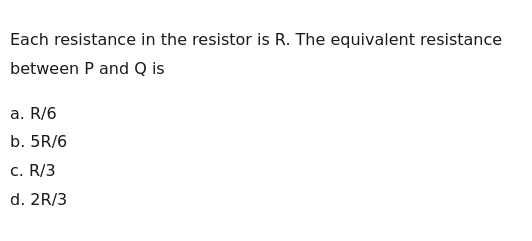Question
Question: Each resistance in the resistor is R. The equivalent resistance between P and Q is...
Each resistance in the resistor is R. The equivalent resistance between P and Q is

R/6
5R/6
R/3
2R/3
5R/6
Solution
The problem asks for the equivalent resistance between points P and Q in a resistor network formed by the edges of a cube, where each edge has resistance R.
We can solve this problem using the concept of symmetry and equipotential points.
-
Identify Equipotential Points:
Let current enter at P and leave at Q.
- Layer 0: Point P.
- Layer 1: The three vertices directly connected to P (let's call them A, B, C) are symmetrically placed with respect to the P-Q axis. Therefore, they are at the same potential. Let this potential be V1.
- Layer 2: The three vertices directly connected to Q (let's call them D, E, F) are also symmetrically placed with respect to the P-Q axis. They are also at the same potential, say V2.
- Layer 3: Point Q.
-
Model the Circuit as Series Combinations of Parallel Resistors:
The entire cube network can be simplified into three stages connected in series:
-
Stage 1: From P to Layer 1 (A, B, C):
There are three resistors (PA, PB, PC) connecting P to the three equipotential points in Layer 1. These three resistors are effectively in parallel between P and the equipotential surface at V1.
The equivalent resistance for this stage is RP→L1=3R.
-
Stage 2: From Layer 1 (A, B, C) to Layer 2 (D, E, F):
Each of the three nodes in Layer 1 (A, B, C) is connected to two nodes in Layer 2 (D, E, F). For example, A is connected to D and E. There are a total of 3×2=6 resistors connecting Layer 1 to Layer 2. Since all nodes in Layer 1 are at V1 and all nodes in Layer 2 are at V2, these 6 resistors are effectively in parallel between the equipotential surfaces V1 and V2.
The equivalent resistance for this stage is RL1→L2=6R.
-
Stage 3: From Layer 2 (D, E, F) to Q:
The three nodes in Layer 2 (D, E, F) are connected to Q. These three resistors (DQ, EQ, FQ) are effectively in parallel between the equipotential surface at V2 and Q.
The equivalent resistance for this stage is RL2→Q=3R.
-
-
Calculate Total Equivalent Resistance:
Since these three stages are in series, the total equivalent resistance between P and Q is the sum of the equivalent resistances of each stage:
RPQ=RP→L1+RL1→L2+RL2→Q
RPQ=3R+6R+3R
To sum these fractions, find a common denominator, which is 6:
RPQ=62R+6R+62R
RPQ=62R+R+2R
RPQ=65R
The equivalent resistance between P and Q is 65R.
